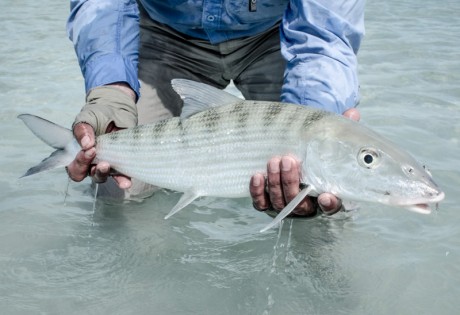
If you freak out a bonefish to the point where he thinks his life’s about to end, you’re much less likely to get him to eat your fly.
Keep those bonefish mellow, mon!
How To Not Spook Bonefish
- Fish lighter flies. One problem with fly selection in a place like South Andros is that our big fish want big flies, but most big commercially tied bonefish flies are designed for the Florida Keys where deep water is the norm – so they’re way too heavy for our fishery. Heavy flies make a loud sound when they enter the water. If the water’s less than 18″ or so deep, stick with bead chain eyes or small lead eye flies.
- Cast a little shorter. If you could choose between too long a cast and too short a cast, too short a cast is almost always better. If you cast too long, you’re really likely to line the fish, which is really likely to send him looking for Mommy. If you cast too short (especially if the fish is coming towards you), you might be able to just leave the fly and let the fish swim up to it. Too short is almost always better than too long.
- False cast off target. If you must make false casts in the vicinity of the fish (the fewer the better!), make sure you’re off to one side or the other. Making a false cast right over the fish’s head will create a scary shadow (birds eat bonefish), and will spray water on to the surface of the flat (not a natural thing at all). Keep your false casts at least 15 feet to either side of the fish – or just stop false casting!
- Be quiet. Don’t slosh your feet in the water when you’re wading. Don’t wear flats boots on the deck of a skiff (squeak, squeak). Don’t slam the lid of the cooler. Don’t drop your bottle of Kalik – set it down softly.
5. Don’t cast at a school if someone else is (even if it is your turn!) The bones are checking out the first fly and too close for another fly to ploop down.
Perhaps this counts towards No. 1 in bonefishing etiquette. I’d love to see
your thoughts on the topic of bonefishing etiquette.